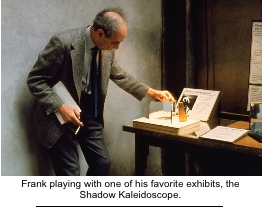| The Exploratorium: A Playful Museum Combines Perception and Art in Science Education | ||||||
| Frank Oppenheimer, Exploratorium American Journal of Physics, Vol 40/7, July 1972 | ||||||
 | ||||||
| The role which museums can play in science education is discussed in general and with particular reference to the Exploratorium in San Francisco. We describe how art, an atmosphere of playfulness, and exhibits about the mechanisms of human sensory perception, have figured in the development of our museum. It is suggested that some of the objectives of interdisciplinary survey science courses can best be achieved in museum like settings where students and general public alike can gain firsthand experience with the fabric of natural phenomena. | ||||||
| contributed by industries, artists, federal agencies, and scientists throughout the country. There are about 200 exhibit pieces. Eventually we should be able to develop about five times this number. The current monthly attendance includes about 6000 school students in scheduled class visits and an additional 15,000-20,000 general public visitors. The general public visitor stays an average of one hour, but many stay two to three hours and return repeatedly. SIGHTSEEING The Exploratorium is a science museum. Certainly not all aspects of science can be communicated in a museum. One cannot do much with those parts of our understanding of nature that depend on mathematical analysis to make them transparent and universal, nor can one teach people how to calculate the right answer or even convincingly assure them that scientists are able to do so. However, in a museum, one can provide an appropriate environment for many of the phenomena of nature. | ||||||
| THE EXPLORATORIUM The Exploratorium is an institution that was conceived to provide opportunities for education that are difficult to achieve in school classrooms or through books, films, and television programs. It has been growing gradually since it opened to the public in September 1969. Its initial funding came through a grant of $50,000.00 from the San Francisco Foundation in May of that year. The Exploratorium leases 90,000 square feet in the recently reconstructed Palace of Fine Arts from the City of San Francisco for a nominal rent. It is supported through grants and donations to the Palace of Arts and Science Foundation, whose chairman is Donald McLaughlin, of the Homestake Mining Company, and a former Regent of the University of California. The initial and rather meager funding has been used to develop exhibits and to operate the museum as a resource for the Bay area. Many exhibits have been presented in the Exploratorium machine and electronic shops by the staff and by students. Others have been | ||||||